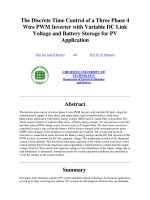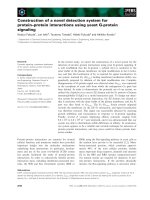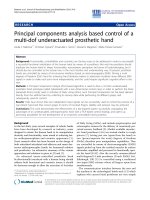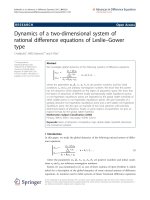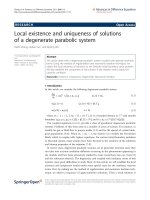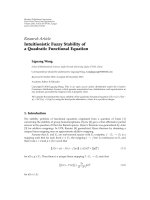Fuzzy Control of a Gantry Crane System
Bạn đang xem bản rút gọn của tài liệu. Xem và tải ngay bản đầy đủ của tài liệu tại đây (140.03 KB, 2 trang )
Project Proposal for Control Theory –
Master of Science in Information Technology
Fall 2004, Control Laboratory, Aalborg University Esbjerg
Fuzzy Control of a Gantry Crane System
Background
Cranes as one of the major equipments in industries, exists in most places - from domestic industries to naval
yards to warehouses, as one example shown in Figure 1. In these places the productivity of the activities
depends on how efficiently the cranes are managed. One of the challenging in the control of the cranes is to deal
with swaying phenomenon introduced by the trolley motion. This swaying not only reduces the efficiency of the
cranes, but also can cause safety problem in the complicated working environment.
Figure 1. A real-world crane system in the harbor
Figure 2. The AUE Crane system
Problem
Many control strategies based on the classic or modern control techniques have been proposed and tested in the
laboratory level for the control of the crane system, such as adaptive control, optimal control, and nonlinear
control etc.. However, from the practical point of view, real-time control requires some simplification of the
experimental model, and human intervention id always necessary for this type of control. Another issue relating
to the case of conventional control is the robustness problem. Some researcher concluded: “Optimal solutions
are only attainable when dealing with a very idealized model of the overhead crane system”. In general, a
controller based on the experience of the human operator is desired for the practical purpose. The aim of fuzzy
control is normally to substitute a fuzzy rule-based system for a skilled human operator. Therefore, within this
project the fuzzy control of a crane system will be investigated.
In AUE some student group has built a physical laboratory crane system as shown in Figure 2. This system will
be used to test the developed methods.
Objective
The objective of this project is to develop and test a fuzzy control method for the AUE crane system. The swing
of the payload should be minimized when the trolley reaches the termination and the traveling time will also be
considered.
Contents
The content can include:
• Hardware improvements: for example, improving the current measuring methods/instruments,
lengthening the traveling frame, improving the pivot mechanism between the cart and the payload
cable, etc;
• Fuzzy control strategy: construction of reference trajectory or reference velocity; development of fuzzy
control rules; defuzzification
Project Proposal for Control Theory –
Master of Science in Information Technology
Fall 2004, Control Laboratory, Aalborg University Esbjerg
•
•
Modeling and Matlab/Simulink simulation
Experimental tests
Since this is a further project based on this system, better system performance are expected through this project.
Reference input
Crane system+ motor
sensors
D/A
Defuzzification
Inference
engine
fuzzification
A/D
Fig. 3 A framework of a Fuzzy Control System
References (can be available upon requirement)
•
•
•
DE-6 Gourp 672 (Spring 2004) report: Control of the Crane Project 2004
A. Benhidjeb and G.L. Gissinger, “Fuzzy control of an overhead crane performance comparison with
classic control”, Control Engineering Practice, Vol.3, No.12, 1995, pp.1687-1696.
J. Yi, Naoyoshi Yubazaki, and Kaoru Hirota, “Anti-swing and positioning control of a overhead
traveling crane”, Information Sciences, Vol.155, 2003, pp.19-42.
Key words: Crane system, fuzzy control, swing control, experimental test
Proposers:
Zhenyu Yang,
Youmin Zhang,
Henrik Legind Larsen,

